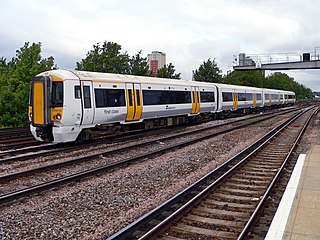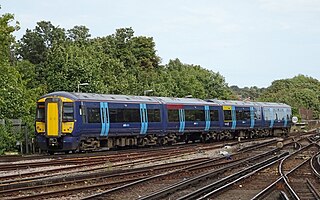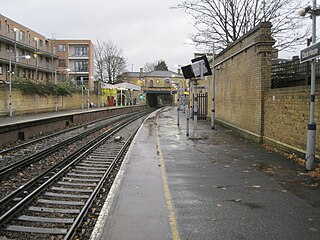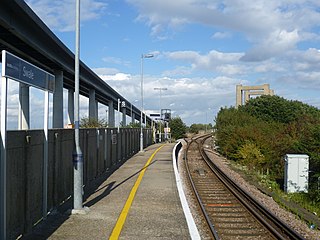
South Eastern Trains was a publicly owned train operating company that operated the South Eastern Passenger Rail Franchise between November 2003, when it took over from Connex South Eastern, and 1 April 2006, when Southeastern began operating the new Integrated Kent franchise.

Metro-Cammell, formally the Metropolitan Cammell Carriage and Wagon Company (MCCW), was an English manufacturer of railway carriages, locomotives and railway wagons, based in Saltley, and subsequently Washwood Heath, in Birmingham. The company was purchased by GEC Alsthom in May 1989; the Washwood Heath factory closed in 2005 and was demolished in early 2019.

The British RailClass 411 (4CEP) electric multiple units were built at Eastleigh works from 1956–63 for the newly electrified main lines in Kent. These units, which used a British Railways Mark 1 bodyshell, were based on the earlier Southern Railway 4 COR design, built in 1937. Variants of the class 411 design included the class 410 and class 412 4 BEP units, which contained a buffet car in place of a standard trailer. They were later used on services in Sussex and Hampshire; following the privatisation of British Rail in 1995, the units were used by the Connex South Central, Connex South Eastern and South West Trains franchises. They were replaced by Juniper, Desiro, and Electrostar units. The fleet's lifespan was 49 years. These units are the longest-lived BR Mark 1 EMUs.

The British Rail Class 375 Electrostar is an electric multiple unit train that was built by Bombardier Transportation at Derby Litchurch Lane Works, from 1999 to 2005. The class form part of the Electrostar family of units, which also includes classes 357, 376, 377, 378, 379 and 387, the most numerous type of EMU introduced since the privatisation of British Rail.

The British Rail Class 365 Networker Express was a class of dual-voltage electric multiple unit passenger train built by ABB at Holgate Road Carriage Works in 1994 and 1995.

St Johns railway station is in the London Borough of Lewisham. It lies 5 miles 47 chains (9.0 km) down the South Eastern Main Line from London Charing Cross, and is situated between New Cross and Lewisham.

Lower Sydenham railway station is located on the boundary of the London Borough of Bromley and the London Borough of Lewisham in south-east London. It is 9 miles 2 chains (14.5 km) measured from London Charing Cross.

New Beckenham railway station serves Beckenham in the London Borough of Bromley in south-east London, in Travelcard Zone 4. It is 9 miles 44 chains (15.4 km) measured from London Charing Cross.

Clock House railway station is in the London Borough of Bromley in south east London, in Travelcard Zone 4 between Beckenham and Penge. It is 10 miles 23 chains (16.6 km) down the line from London Charing Cross. The station and all trains serving it are operated by Southeastern on the Hayes line.

Eden Park railway station serves Eden Park in the London Borough of Bromley in south east London, in Travelcard Zone 5. It is therefore possible to use an Oyster card at the station. It is 12 miles 34 chains (20.0 km) down the line from London Charing Cross. The station and all trains serving it is operated by Southeastern on the Hayes line. The trains are electric, powered by a third rail.

West Wickham railway station serves West Wickham in the London Borough of Bromley. It is located in Southeast London and is in Travelcard Zone 5. It is 13 miles 19 chains (21.3 km) down the line from London Charing Cross.

The Sheerness line is located in Kent, England, and connects Sheerness-on-Sea on the Isle of Sheppey with Sittingbourne on the mainland, and with the Chatham Main Line for trains towards London, Ramsgate or Dover Priory. It opened on 19 July 1860.

The British Rail Class 508 (4PER) was a type of electric multiple unit (EMU) passenger train built by British Rail Engineering Limited, at Holgate Road carriage works, York, in 1979 and 1980. They were a variant of British Rail's standard 1972 design for suburban EMUs, eventually encompassing 755 vehicles and five classes (313/314/315/507/508). They mostly worked on the Merseyrail network from 1982 until withdrawal on 16 January 2024.

The British Rail Class 376 Electrostar is a class of electric multiple unit passenger train that was manufactured by Bombardier Transportation at its Derby Litchurch Lane Works. It is part of the Electrostar family, which are the most common EMUs introduced since the privatisation of British Rail. The units were ordered by Connex South Eastern and introduced in 2004/2005 by South Eastern Trains to replace Class 465 and Class 466, which were transferred to Outer Suburban services to Kent to replace the Class 423 slam-door trains.

The British Rail Class 465 Networker is a class of 147 electric multiple units built by Metro-Cammell, British Rail Engineering Limited (BREL) and ABB Rail between 1991 and 1994. Originally operated by Network South East, these units are now run by Southeastern.

The Bombardier Electrostar is a family of electric multiple-unit (EMU) passenger trains manufactured by Bombardier Transportation at their Derby Litchurch Lane Works in England between 1999 and 2017. It has become the most common new EMU type in the United Kingdom since the privatisation of British Rail with a number of variants. Electrostar trains are most common on high-volume suburban commuter routes around London; and on mainline services from London south to Surrey and the south coast, east to Essex, and north to Cambridge and Stansted Airport.

Connex South Eastern was a train operating company in the United Kingdom owned by Connex that operated the South Eastern franchise from October 1996 until November 2003.

The East Rail line Metro Cammell EMU was a model of electric multiple unit built in 1980–1990 by Metro-Cammell for the original Kowloon–Canton Railway in Hong Kong. The 29 sets were owned by and were originally operated by the Kowloon-Canton Railway Corporation (KCRC). They were operated by MTR Corporation (MTRC) after it merged with KCRC in 2007. Although another set of EMU trains from the same manufacturer operate on some of MTR's own lines, there are some significant differences between the two models, with the Metro Cammell EMUs of the original MTR being known as the Modernization Train.

The Networker is a family of passenger trains which operate on the UK railway system. They were built in the late 1980s and early 1990s by British Rail Engineering Limited and Metro Cammell. The trains were built for the Network SouthEast (NSE) sector of British Rail, which is where their name comes from. They are all multiple-unit trains.

SE Trains Limited, trading as Southeastern, is a British train operating company owned by DfT OLR Holdings for the Department for Transport, that took over operating the South Eastern franchise in South East England from privately owned London & South Eastern Railway on 17 October 2021.





















